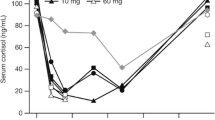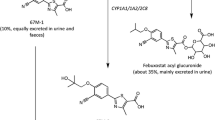Summary
Prednisone and prednisolone are used in a wide variety of diseases. The two compounds are metabolically interconvertible; prednisolone is assumed to be the pharmacologically active species.
Prednisone and prednisolone plasma concentrations are commonly determined by either radioimmunoassay or competitive protein binding techniques. No relationship has been demonstrated between prednisolone plasma concentration (unbound or total concentration) and clinical response; alternate day dosage regimens with fluctuating plasma concentrations being considered generally to be as effective with less side effects than a daily dosage regimen.
Both drugs are rapidly absorbed after oral administration, reaching peak plasma concentrations after 1 to 3 hours. In general, plasma half-lives for prednisone are slightly longer (3.4 to 3.8h) than for prednisolone (2.1 to 3.5h). Either drug can be prescribed in most situations. On average, however, the bioavailability of prednisolone after oral prednisone is approximately 80% of that after prednisolone. A wide intersubject variation in prednisolone concentration is evident after both drugs, which may suggest impaired drug absorption in some individuals.
Prednisolone shows dose dependent pharmacokinetics; an increase in dose leading to an increase in volume of distribution and plasma clearance. This can be explained in terms of the non-linear binding of the drug to plasma proteins. The degree of binding will determine the distribution and clearance of free (i.e. pharmacologically active) drug. Reduced doses are recommended in patients with hypoalbuminaemia.
Prednisolone pharmacokinetics are also dependent on age; the half-life being shorter in children. Liver disease prolongs the prednisolone half-life and, due to the frequently associated hypoalbuminaemia, also increases the percentage of unbound drug. It has been recommended by some that prednisolone rather than prednisone is the drug of choice in active liver disease owing to the poor conversion of prednisone to prednisolone in some patients. However, the reduced plasma concentration of prednisolone in such patients is compensated for by delayed clearance. Thus, there is little advantage of one preparation over the other.
Pharmacokinetic drug interactions have been reported, particularly accelerated clearance of prednisolone due to enzyme inducing agents such as barbiturates, phenytoin, rifampicin and other corticosteroids. On the other hand, oral contraceptives have been reported to increase the half-life and to decrease distribution volume and clearance of prednisolone, due to the increased levels of corticosteroid binding globulin (transcortin).
Similar content being viewed by others
Author information
Authors and Affiliations
Rights and permissions
About this article
Cite this article
Pickup, M.E. Clinical Pharmacokinetics of Prednisone and Prednisolone. Clin-Pharmacokinet 4, 111–128 (1979). https://doi.org/10.2165/00003088-197904020-00004
Published:
Issue Date:
DOI: https://doi.org/10.2165/00003088-197904020-00004




